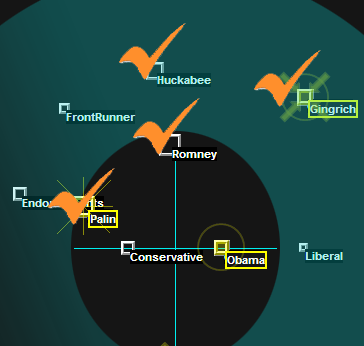News Patterns has been operating an active intelligence network regarding possible Republican contenders for the 2012 US Presidential primary election. Every day thousands of news and blog articles are collected, filtered for noise, and searched for interesting connections and patterns. After billions of pattern matching calculations are completed, a News Radar is produced that represents connections and relationships among the news topics. In the case of the 2012 radar, the topics are potential 2012 contenders and the issues that may define them in a prospective campaign. As new news is collected and patterned, the News Radar moves and evolves to reflect the new data.
On August 28, 2010 the 2012 Presidential News Radar displayed that the top GOP contenders were Romney, Palin, Huckabee, Gingrich, Bush and Paul in this order. In the following image, one can see these top contenders clustered about the center of the 2012 News Radar. Additionally, the distance that a candidate is plotted from the radar center is typically inversely proportional to actual polling results. For example, in the displayed news radar as follows and in larger version here, the 2012 News Radar would indicate to us that Romney and Palin were the top contenders as measured by news patterning.

Also on August 27 and 28, 2010, a poll of Alaska voters was taken, probing likely preferences for 2012 GOP candidates. The results were published in Politico and are as follows: Romney 20%, Palin 17%, Huckabee 17%, Gingrich 16% and Paul 10%. The results did not state if other candidates like Jeb Bush were also included in the poll.
The thing to notice in comparing the News Patterns results with the Alaska poll results are that they are remarkably similar in the list of the names and the order of those names. The polling method started with a forced list of names that were used to question Alaska voters. The News Patterns method started with thousands of news and blog articles that calculated into a primary list of 2012 candidates with some sense of priority. This is a good example where News Patterns algorithms can approximate other methods (polling) of determining the collective beliefs of groups of people.
